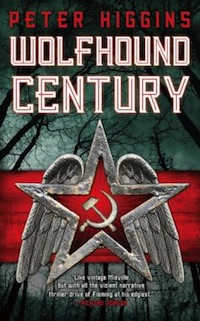The epigraph of Higgins’ debut novel is a line from the poetry of Osip Mandelstam*: The wolfhound century is on my back/But I am not a wolf. This image, as metaphor, is one that forms the novel’s thematic underpinnings: a contest between hunter and prey in which definitions are fluid, in which the world itself is fluid, in conflict with the cold, rigid requirements of the totalitarian state of the Vlast.
Vissarion Lom is a policeman, and a good one, part of the Vlast’s machinery of control. Summoned to Mirgorod, the capital, to capture a terrorist/nihilist, he discovers the apparatus of the state to be more corrupt than he had expected: that terrorism and ambition go hand in hand, and that the world of secret police and revolutionaries, cabaret clubs and politically suspect academics, lies interpenetrated with older, stranger things. Viassarion Lom is an outsider to the capital, outside its power struggles. But he has a piece of angel stone implanted in his forehead, and a personal connection with the forest whose existence predates the arrival of the first dead stone angels whose fall coincided with—spurred—the foundation of the Vlast. This forest’s dwellers—its powers—can unlock new potential futures, a new potential past, for the lands covered by the Vlast. Vissarion, and the young woman Maroussia Shaumian—who believes she is the daughter of a terrorist, while really being the daughter of one of the forest’s powers—find themselves at the centre of the struggle for the future of the Vlast, for Mirgorod, and for Lezarye, the land that existed before the Vlast. A struggle grown more urgent now: for a live stone angel has fallen in the forest, and is poisoning its heart.
Peter Higgins does two things amazingly well. The first is turn a phrase: his imagery is studied, vivid, measured, striking: at times gorgeous, at times repellent, but never less than apt. The second is tone: there is a fantastically melancholic-yet-oppressive air about the scenes in Mirgorod, a combination of claustrophobia and instability accentuated by Higgins’ facility with the numinous—and he brings the numinous to the fore.
The woman behind the counter smiled at her. The smile was a sunburst of love, extraordinary, generous and good, and in the moment of that smile it happened: the surface of the world split open, spilling potential, spilling, possibility, spilling the hidden truth of things.
…Cautiously, slowly, so as not to disturb the limpid surface of the moment, Vishnik raised his camera to his eye and released the shutter.
Higgins’ creation bears strong Russian influences. I can’t speak to how respectfully he used them, but the whole they come together to form is a world balanced between older, quieter, organic power and the cold influence of the dead stone angels, between forest and city and marsh. A layered, nuanced world. It has giants and golems (by another name) and the files of the secret police. It has pace and tension. Its characterisation is solid. It builds quite nicely until about twenty pages from the end.
But I was expecting more in terms of climactic resolution than this volume provided. It would’ve been nice to have some indication that this is a series book, and—for all its many excellent points—a set-up book, at that. Very few of the major conflicts implied in the opening chapters of Wolfhound Century are resolved by its close: it’s not complete in itself. Without something more in the way of emotional and/or narrative resolution, I’m not at all sure I can give a fair assessment: my expectations bias themselves.
I can say, though, that the writing is fluent, the imagery startling good, and if Higgins proves himself capable of climactic resolution in the sequel, he’ll be more than a promising novelist. He’ll bid fair to be a really good one.
*And I’m glad to have heard of Mandelstam: I’ve found another poet to love!
Wolfhound Century is published by Orbit. It is available March 26.
Find Liz Bourke on Twitter @hawkwing_lb, and on her blog.










